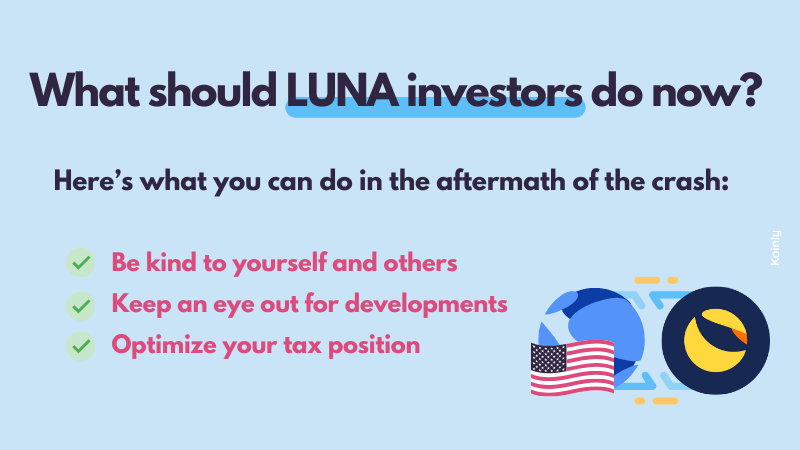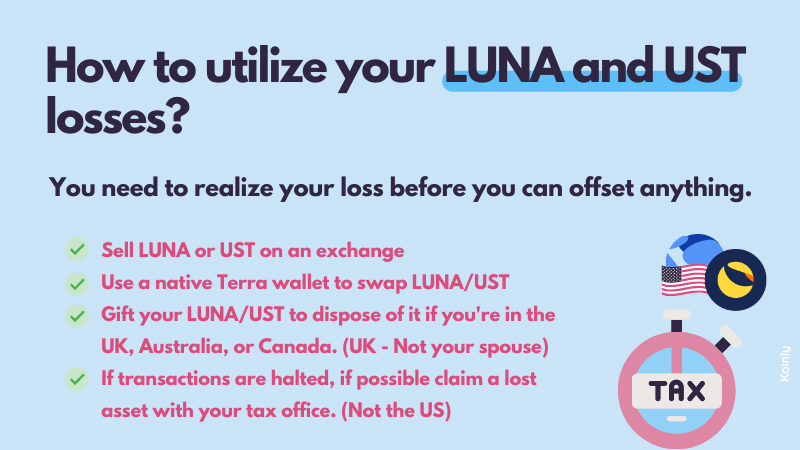The Terra Crash: What Happened and How to Cut Your Losses
Just six months after a record high, the global crypto market cap has plummeted by $1.9 trillion - a brutal $0.6 trillion more in losses than the 2007 subprime mortgage market crisis. No crypto has been spared, but Terra’s native coin LUNA has lost 99.9% of its value in a single week alone, due to their algorithmic stablecoin UST proving to be far from stable. Here’s exactly what happened and what Terra investors can do now.
Why did LUNA crash?
The LUNA crash started on May 9, 2022, and the story isn't over yet. But to understand why LUNA crashed, you need to understand how Terra functioned and grew initially.

Terra 101
LUNA is the native token of Terra - a blockchain that specializes in stablecoins.
There are plenty of different flavors of stablecoins and the vast majority of them - like USD, USDT, and BUSD - are collateralized stablecoins. This means they utilize fiat currency as a reserve (to peg their value). The centralized entities that issue these stablecoins hold a treasury of US dollars and other financial assets, which means that at any point you can trade your USD, USDT, or BUSD for the dollar value. These reserves are utilized to maintain price parity in the event of a depeg.
Terra's stablecoin - TerraUSD (UST) - doesn't work like this. Controversially, it's an uncollateralized algorithmic stablecoin, backed by Terra's native token LUNA.
So instead of trading your UST for the dollar value it's pegged at - you trade it for LUNA, and vice versa when you want to buy UST. The protocol effectively incentivizes users to stabilize the price. For example, when UST is trading above $1, investors are incentivized to burn LUNA to mint UST. When UST is trading below $1, investors are incentivized to burn UST to mint LUNA.
This mechanism led to massive growth for Terra since its launch. UST’s mechanism meant it didn't need to be overcollateralized like DAI and the amount of LUNA burned to create UST decreased the supply, which sent the price of LUNA soaring.
But this mechanism works both ways. The same mechanism that caused LUNA's rapid price increase can also create rapid price decreases when the scales tip the other way - particularly in the event of UST depegging or a rapid decrease in the supply of UST.
So… what happened to UST?
The specifics aren’t all that clear yet - but here’s what we know so far.
Over the course of the past week, UST depegged multiple times, mostly due to the Anchor Protocol - a popular lending protocol on the Terra blockchain letting investors earn up to 20% APY on UST deposits.
Most UST investments were related to the Anchor protocol. On May 7, 2022, a huge withdrawal of around $2 billion of UST from the Anchor protocol and an immediate UST sell-off on Saturday seems to have triggered the initial depeg as UST dropped to $0.91. Whether this was a malicious attack or simply a reaction to a volatile market is currently unknown.
Regardless, this price discrepancy attracted arbitrage traders. This overinflated the supply of LUNA, forcing the price down. The total supply of LUNA rose from 725 million tokens on May 5 to 7 trillion tokens on May 13. As the value plummets, more investors panic and sell, causing the price to drop even further. It's this chain of events that effectively caused a death spiral.
Despite attempts from the Luna Foundation Guard to use their $1.5 billion in BTC reserves to defend the UST peg and even halting transactions on the Terra blockchain, the Terra protocol algorithm has been unable to bring UST back to $1. At the time of writing, between UST and LUNA, more than $40 billion in value has been lost.
Wider implications of the Terra crash
The LUNA and UST crash is sending shockwaves through the crypto market and beyond, causing uncertainty and a lot of theories about what happened.
A widely spread theory is that the sale of UST was a concerted attack by a whale - likened to George Soros' famous bet against GBP in the 1990s. In brief, the theory states that a crypto investor with a huge BTC short position dumped billions in UST to deliberately depeg it and force the Luna Foundation Guard to sell Bitcoin reserves, in turn, forcing the price of BTC down.
The depeg of one of the most popular stablecoins in the market has had a knock-on effect on confidence in other stablecoins. Large sell-offs have caused even the largest stablecoin, Tether (USDT), to briefly lose its peg in the last week - although USDT has covered at the time of writing after utilizing its fiat reserves.
The Crypto Fear & Greed Index is at Extreme Fear - and this sentiment is bleeding into other markets. Where crypto was once fairly isolated, stablecoins - like Tether - hold billions in commercial paper, treasury notes, and corporate bonds in reserves - if they're forced to sell these off to maintain price parity, this may have a ripple effect on other markets.
What happens now for LUNA investors?
It’s not too clear just yet what will happen for LUNA and UST investors.
During the crash - the Luna Foundation Guard (LFG) confirmed they would loan out their BTC reserves to market makers to defend the UST peg. Terraform Labs CEO, Do Kwon, also announced the reserve funds were being topped up by an additional $850 million in BTC.
But it's not clear what happened to these reserves. On May 9th, $1.6 billion of BTC was transferred from LFG's wallet to crypto exchange Gemini, and a further $875 million was sent to a Binance wallet - but what happened to these funds after this point is unclear.
On Friday the 13th of May 2022, Do Kwon tweeted he was "heartbroken about the pain my invention has brought on all of you" and that Terra Labs was working on documenting the use of the LFG BTC reserves. He also presented a potential revival plan in the form of a fork - but it’s been met with harsh criticism.
In general, the sentiment from LUNA investors is pessimistic and the majority believe the project is dead.
In a small glimmer of good news - despite the crash, the wider market has proven to be more resilient than many expected. While no coin has come out unscathed - other popular coins have shown signs of recovery since the chaos of last week.
Update
Despite a large proportion of the LUNA community voting "no with veto" on the hard fork proposal, it looks like the proposal has received enough votes to pass.
This means at the time of writing, the Terra blockchain will split into Terra Classic with LUNC (formerly LUNA) and the new chain will be Terra with the LUNA token. Anyone who holds LUNA or UST at the time of the fork will receive an airdrop of new LUNA coins. The new chain will not include algorithmic stablecoins.
For investors, this leaves two choices - either hold UST and LUNA until the fork (currently happening on the 27th of May) and see what happens to the new LUNA chain and their value to see if they can gain any of their original investment back, or cut your losses by disposing of your LUNA and UST tokens.
What should LUNA investors do now?
If you’ve invested in LUNA, or you know someone else who has invested in LUNA, here’s what you can do in the aftermath of the crash.

Be Kind
More importantly than anything else - be kind to yourself and others. Many investors have lost their life savings to the crash. Make sure to reach out to someone if you need to, or make sure to reach out to friends you know with LUNA or UST investments.
Wait for news
This story is still developing - so keep an eye out for developments. Binance CEO, Zhao, has just confirmed that Binance will protect users first and that they’re asking the Terra project team to compensate retail users of LUNA and UST first. Zhao also publicly backed a proposal on Twitter asking Terra to prioritize smaller wallets first should the BTC reserves be used to compensate UST investors.
In other words, even though the Terra project is likely over - some UST investors may see compensation yet.
Optimize your tax position
We get it - tax is a very small silver lining when the losses are this big, but it can at least help put investors in a slightly better financial position.
We’ve updated our Terra taxes guide to give more advice on how to utilize your LUNA and UST losses in order to reduce your tax bill, but in brief:
You’ll need to realize your losses from LUNA or UST before you can offset anything. This means you need to dispose of your LUNA or UST by selling it, swapping it, or potentially gifting it.
The simplest way to realize a loss is to sell LUNA or UST on an exchange. However, many exchanges have now delisted the pair.
Investors may be able to use a native Terra wallet to swap UST and LUNA. This swap is a disposal from a tax perspective, so it ensures you’ll realize a loss on your asset.
If you’re in the UK, Australia, or Canada, you can also gift your LUNA or UST to dispose of it and realize a loss. In the UK, this would need to be to someone other than your spouse.
If transactions are halted on the Terra blockchain permanently, you may be able to claim a capital loss depending on where you live. In Australia, Canada, and the UK, there are reasonable grounds to claim your crypto asset has been destroyed and its value reduced to zero. With proof, you could claim this loss as a deduction against your capital gains, based on your original cost base for the asset.
Unfortunately, US investors cannot claim these kinds of losses, they must realize their loss in order to reduce their tax bill.
Once you’ve realized your loss, you’ll be able to offset this against any capital gains and carry unutilized losses forward as a minimum, and some countries (like the US) will let you offset an additional amount against your income.
A word of warning though - make sure you optimize your tax position by the end of the financial year in your country. You can learn more in our country tax guides about when the EOFY is in your country- but for many investors, it’s soon. For example, Australian investors only have until the 30th of June to optimize their tax position.

Update 2023
The IRS has released guidance clarifying its stance on taxpayers with crypto assets worth less than $0.01 - and if you're one of the unfortunate investors left with worthless UST tokens, it's not good news. The IRS says there can be no deduction for losses on holdings that have dropped to less than one cent. Even if the asset appears "worthless or abandoned", it has not been sold and therefore there is no disposal and no loss.
Using Koinly to do your LUNA/LUNC taxes? Read our help guide.
TLDR;
LUNA and UST have crashed to almost $0 in the past week.
The crash was caused by rapid UST sell-offs causing several de-pegs.
The impact on the wider crypto market is significant.
A lack of confidence in stablecoins is causing a ripple effect on other markets.
UST investors may be compensated, so wait for news.
LUNA investors may be able to realize their losses and use them to reduce their tax bills significantly.



